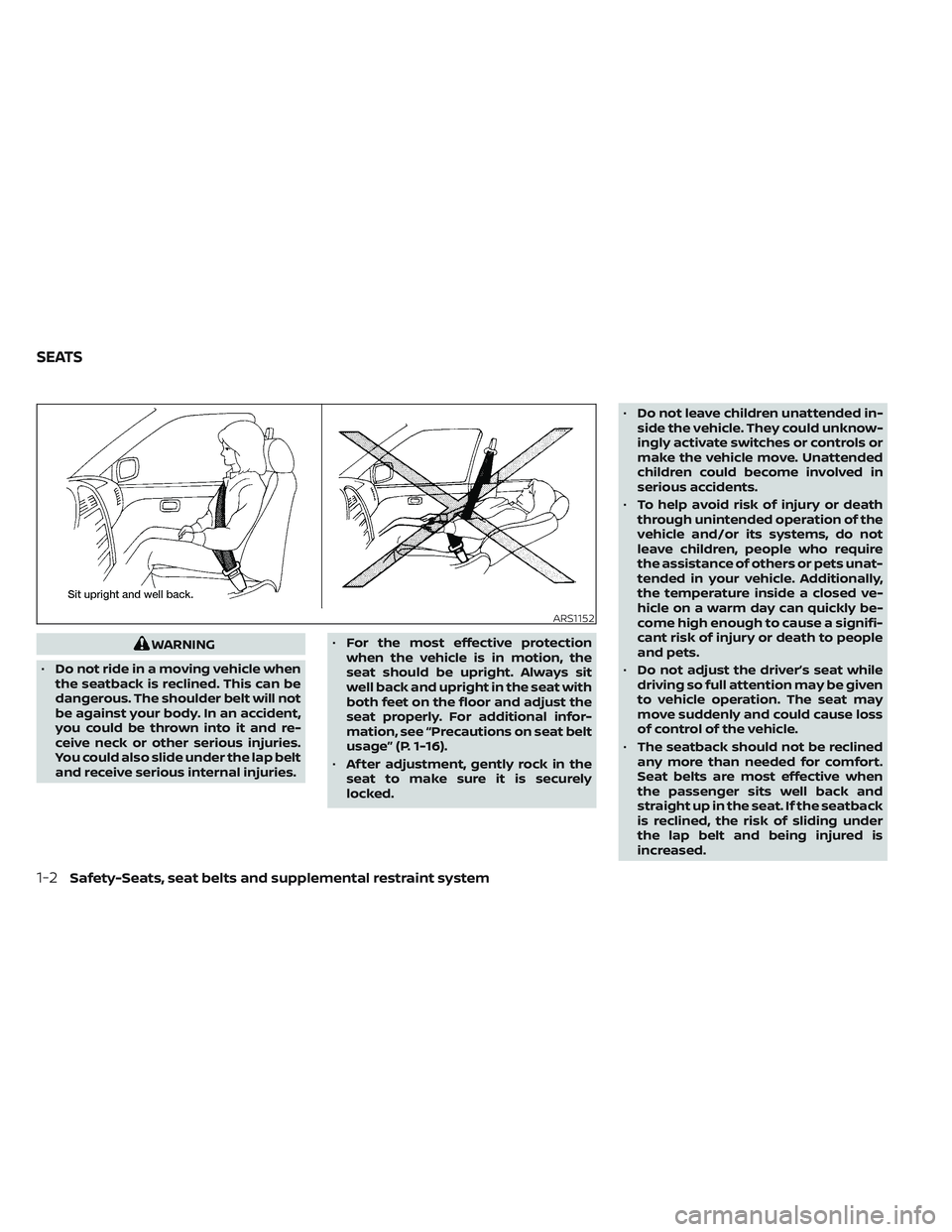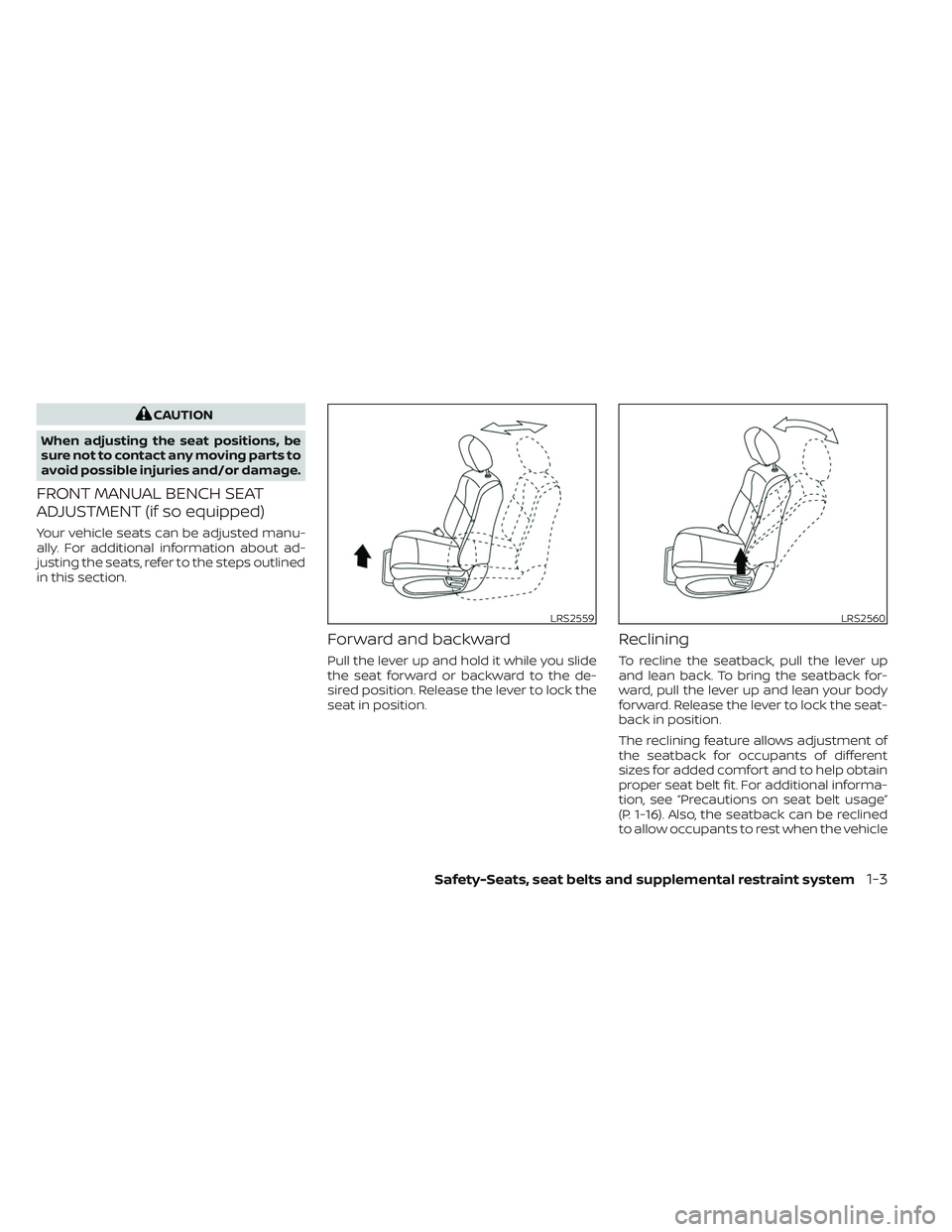Page 11 of 635
1. Antenna (P. 4-42)
2. Power windows (P. 2-82)
3. Windshield (P. 8-22)
4. Wiper and washer switch (P. 2-41)5. Engine hood (P. 3-23)
6. Front view camera (if so equipped)
(P. 4-11)
7. Recovery hooks (if so equipped) (P. 6-16) 8. Front fog lights (if so equipped) (P. 2-52)
LED Daytime Running Lights (DRL)
system (if so equipped) (P. 2-50)
Front sonar sensors (if so equipped)
(P. 5-124)
9. Headlight and turn signal switches
(P. 2-45, 2-51)
Replacing bulbs (P. 8-29)
LED Daytime Running Lights (DRL)
system (if so equipped) (P. 2-50)
10. Tire pressure (P. 8-33) Flat tire (P. 6-3)
Tire chains (P. 8-42)
11. Mirrors (P. 3-29) Side view camera (if so equipped)
(P. 4-11)
12. Door locks (P. 3-4) NISSAN Intelligent Key® system (P. 3-9)
Refer to the page number indicated in
parentheses for operating details.
NOTE:
Crew Cab model shown, King Cab® model
similar.
LII2732
EXTERIOR FRONT
Illustrated table of contents0-3
Page 12 of 635
1. Cargo lamp (P. 2-53)
2. Rear sliding window (P. 2-85)3. Bed liner storage bins (if so equipped)
(P. 2-80)
4. Under rail bed lamps (if so equipped)
(P. 8-30) 5. Truck box (P. 3-34)
Tailgate (P. 3-34)
Rearview camera (P. 4-10)
6. Towing (P. 10-32)
7. Rear sonar sensors (P. 5-124)
8. Replacing bulbs (P. 8-29)
9. Fuel-filler cap (P. 3-23) Fuel-filler door (P. 3-23)
Fuel recommendation (P. 10-4)
10. Child safety rear door lock
(if so equipped) (P. 3-4)
Refer to the page number indicated in
parentheses for operating details.
NOTE:
Crew Cab model shown, King Cab® model
similar.
LII2733
EXTERIOR REAR
0-4Illustrated table of contents
Page 15 of 635

18. USB ports*
19. Hazard warning flasher switch (P. 6-2)
20. Parking Aids system switch (P. 2-62)Vehicle Dynamic Control (VDC) OFF
switch (P. 2-58)
21. Trailer Brake Controller Unit (TBCU)
(if so equipped) (P. 2-63)
22. 4WD shif t switch (if so equipped)
(P. 5-111)
23. Push-button ignition switch (P. 5-13)
24. Driver supplemental knee air bag
(P. 1-80)
25. Tilt and telescopic steering wheel
control (P. 3-26)
26. Parking brake (P. 5-23)
27. Hood release (P. 3-23)
28. Headlight aiming control
(if so equipped) (P. 2-45)
Power inverter switch (if so equipped)
(P. 2-61)
Cargo lamp switch (P. 2-53)
Electronic locking rear differential
(E-Lock) system switch (if so equipped)
(P. 2-60)
Hill descent control system switch
(if so equipped) (P. 2-59) 29. Headlight switch (P. 2-45)
Fog light switch (if so equipped) (P. 2-52)
Instrument brightness control
switches (P. 2-51)
Trip reset switch (P. 2-7)
*Refer to the separate NissanConnect®
Owner’s Manual
Refer to the page number indicated in
parenthesis for operating details.
Illustrated table of contents0-7
Page 18 of 635
Warning/Indicator
light (red) Name Page
Automatic
Transmission
Park warning light
(
model)2-13
Brake warning
light
2-14
Charge warning
light 2-15
Electric shif t
control system
warning light2-15
Engine oil
pressure
warning light2-15
Malfunction
Indicator Light
(MIL)2-15
Warning/
Indicator
light (red) Name Page
Master warning
light
2-16
Seat belt warning
light and chime2-16
Security indicator
light2-16
Supplemental air
bag warning light2-16
Warning/
Indicator light
(yellow) Name Page
Anti-lock Braking
System (ABS)
warning light
2-17
Automatic
Emergency
Braking (AEB) with
Pedestrian
Detection system
warning light2-17
Automatic
Transmission
check warning
light
2-18
Electronic locking
rear differential
(E-Lock) system
ON indicator light
(if so equipped)2-18
WARNING AND INDICATOR LIGHTS
0-10Illustrated table of contents
Page 22 of 635

WARNING
• Do not ride in a moving vehicle when
the seatback is reclined. This can be
dangerous. The shoulder belt will not
be against your body. In an accident,
you could be thrown into it and re-
ceive neck or other serious injuries.
You could also slide under the lap belt
and receive serious internal injuries. •
For the most effective protection
when the vehicle is in motion, the
seat should be upright. Always sit
well back and upright in the seat with
both feet on the floor and adjust the
seat properly. For additional infor-
mation, see “Precautions on seat belt
usage” (P. 1-16).
• Af ter adjustment, gently rock in the
seat to make sure it is securely
locked. •
Do not leave children unattended in-
side the vehicle. They could unknow-
ingly activate switches or controls or
make the vehicle move. Unattended
children could become involved in
serious accidents.
• To help avoid risk of injury or death
through unintended operation of the
vehicle and/or its systems, do not
leave children, people who require
the assistance of others or pets unat-
tended in your vehicle. Additionally,
the temperature inside a closed ve-
hicle on a warm day can quickly be-
come high enough to cause a signifi-
cant risk of injury or death to people
and pets.
• Do not adjust the driver’s seat while
driving so full attention may be given
to vehicle operation. The seat may
move suddenly and could cause loss
of control of the vehicle.
• The seatback should not be reclined
any more than needed for comfort.
Seat belts are most effective when
the passenger sits well back and
straight up in the seat. If the seatback
is reclined, the risk of sliding under
the lap belt and being injured is
increased.
ARS1152
SEATS
1-2Safety-Seats, seat belts and supplemental restraint system
Page 23 of 635

CAUTION
When adjusting the seat positions, be
sure not to contact any moving parts to
avoid possible injuries and/or damage.
FRONT MANUAL BENCH SEAT
ADJUSTMENT (if so equipped)
Your vehicle seats can be adjusted manu-
ally. For additional information about ad-
justing the seats, refer to the steps outlined
in this section.
Forward and backward
Pull the lever up and hold it while you slide
the seat forward or backward to the de-
sired position. Release the lever to lock the
seat in position.
Reclining
To recline the seatback, pull the lever up
and lean back. To bring the seatback for-
ward, pull the lever up and lean your body
forward. Release the lever to lock the seat-
back in position.
The reclining feature allows adjustment of
the seatback for occupants of different
sizes for added comfort and to help obtain
proper seat belt fit. For additional informa-
tion, see “Precautions on seat belt usage”
(P. 1-16). Also, the seatback can be reclined
to allow occupants to rest when the vehicle
LRS2559LRS2560
Safety-Seats, seat belts and supplemental restraint system1-3
Page 25 of 635
Forward and backward
Pull the lever up and hold it while you slide
the seat forward or backward to the de-
sired position. Release the lever to lock the
seat in position.
Reclining
To recline the seatback, pull the lever up
and lean back. To bring the seatback for-
ward, pull the lever up and lean your body
forward. Release the lever to lock the seat-
back in position.The reclining feature allows adjustment of
the seatback for occupants of different
sizes for added comfort and to help obtain
proper seat belt fit. For additional informa-
tion, see “Precautions on seat belt usage”
(P. 1-16). Also, the seatback can be reclined
to allow occupants to rest when the vehicle
is stopped and the shif t lever is in the P
(Park) position.
LRS2559LRS2560
Safety-Seats, seat belts and supplemental restraint system1-5
Page 29 of 635
Folding the rear bench seat up
To fold the rear bench seat up for storage
capacity behind the front seats or to re-
move the jacking tools from the storage
area:
1. Lif t the front of the seat cushion up.2. Fold the bottom of the seat cushion to-
ward the back of the vehicle until it locks
in place. 3. Repeat this process to raise and secure
the seat cushion on the other side of the
vehicle for maximum storage capacity.
To return the rear bench seat to a seating
position, pull the latch on the bottom of the
seat cushions to release the seat from the
locked position. Make sure to properly
push the seat cushion down into place.
LRS2766LRS2767LRS2768
Safety-Seats, seat belts and supplemental restraint system1-9